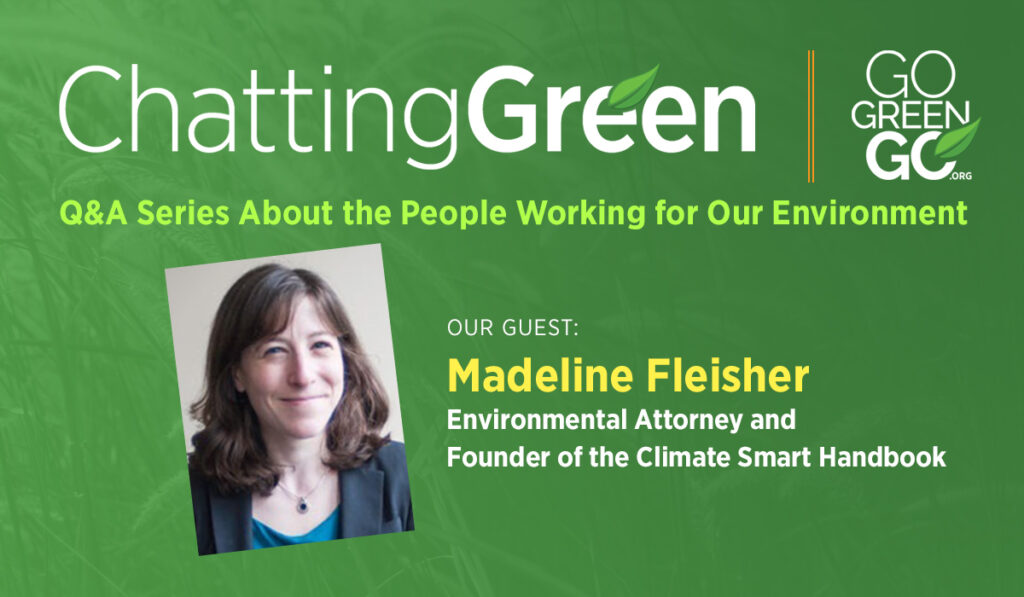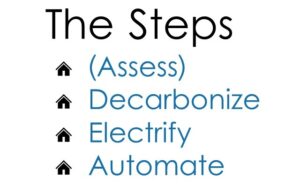Chatting Green with Madeline Fleisher of The Climate Smart Handbook
- Chatting Green
-
May 06
- Share post

Madeline Fleisher, Founder of the Climate Smart Handbook, joins us for this installment of Chatting Green. Madeline is an environmental attorney who spent time with the U.S. Department of Justice, the Environmental Law & Policy Center, and now works on environmental and sustainability issues in the manufacturing sector. Her latest project, The Climate Smart Handbook, is a website offering an in-depth, step-by-step guide to switching your home to clean energy. Check out the Climate Smart Handbook at www.climatesmarthandbook.com and follow Madeline on Twitter @CleanEnergyNerd.
…
Your project, The Climate Smart Handbook, tackles how individuals can take control of their own climate footprint by making their homes more energy efficient, while making the switch to clean energy. What inspired you to create this resource? Why do the issues or energy efficiency and clean energy mean so much to you?
I’m certainly not the only person in the world who’s concerned about the ongoing and future impacts of climate change. For the last fifteen years, I’ve been fortunate enough to be able to try to do something about the issue as an environmental and energy attorney, with a focus on policies relating to clean energy options for ordinary consumers. I’ve seen that those options are becoming more accessible every day, whether it’s renewable energy, electric vehicles, heat pumps, or smart thermostats. But when I’d talk to family, friends, and neighbors about my work, I’d often come away with the impression that switching to clean energy didn’t necessarily seem so easy to them. They would have legitimate questions about the state of the technology, or the availability of financial assistance, or just the nuts and bolts of how you “shop” for renewable power. And when I would look for resources to point them to in order to answer those questions, I found that there were bits and pieces scattered around everywhere, but not one consolidated, detailed how-to guide covering all the essential steps.
The Climate Smart Handbook website is my quixotic attempt to provide that how-to guide for clean energy at home. When I dream big, my hope is that it’s a template for a more widespread effort at developing educational resources for a growing “mass market” of clean energy consumers. It feels like our society is awash with how-to seminars and handbooks on everything from financial investment to baking, and on the commercial side there’s a cottage industry of consultants helping businesses become more sustainable. I believe that the same types of tools should be available for folks ready, willing, and able to invest in reducing their climate footprint.

A lot of municipalities and energy providers offer resources on energy efficiency to their residents and customers. But most of it is “turn off your lights when you leave a room” or “install weather stripping”. These are important, but not exactly fresh thinking. How is The Climate Smart Handbook different?
It’s different for two main reasons. First, if those lists are ten or even five years old, they may well be out of step with the current clean energy market. If your electricity supply is renewable, leaving your lights on and using a bit more of that clean power may not have a huge climate impact. Likewise, the time and money you would spend on installing weather stripping might be better spent putting in a smart thermostat that can not only reduce your energy waste but also manage your air conditioning to make sure that when it does run it’s powered by renewable electricity. The energy sector has really transformed in recent years, with more to come, and the Climate Smart Handbook incorporates the latest and greatest technologies and tools available for clean energy consumers.
Second, the Climate Smart Handbook goes beyond the “list” approach to actually offer detailed information on when and how you can most effectively reduce your climate footprint, A laundry list of 10 or 50 items doesn’t tell you what should come first, or how to tap into incentive programs to make clean energy more affordable, or which are the one or two most important things on the list. With my website, I’m trying to fill in those gaps so that you don’t just have a list, you have a real action plan for transforming your energy use at home.

On your website, you make a very important distinction that electricity prices differ from fossil fuel prices because they vary by time of day. This means everything electric in a person’s home can potentially be cheaper if they time it right. Can you expand on this concept?
Really this is just one example of the economic concept of supply and demand. We’re all familiar with the idea that apples are cheaper at the grocery store when they’re in season and there’s plenty of supply, or that gas prices tend to go up on big holiday weekends like Memorial Day when long vacation road trips means more demand. The main difference when it comes to electricity is that supply and demand have to be managed on the power grid on almost a minute-to-minute basis – if that balance gets out of whack, the grid breaks down and you end up with blackouts. Over the last decade or so, millions of “smart” electric meters have been installed across the U.S. that can measure your home electricity usage on that same minute-by-minute level. That means some utilities are now applying supply-and-demand-based pricing in your home electric rates, charging less when demand is low (often nights and weekends) and more when it’s high (like on hot summer afternoons), instead of a uniform rate per kilowatt-hour where you pay the same amount for electricity no matter how plentiful or scarce it is.
This daily variation in pricing isn’t always directly related to clean energy (although it can be), but if you’re looking at buying items like electric vehicles or home heat pumps that can run on carbon-free electricity, you can leverage “time-based” rates to reduce the overall costs of those electric investments. Whether it’s free charging at night for an electric vehicle, or bill credits for reducing your electric heating or cooling at peak times, time-based rates can help make clean energy investments more affordable – or even cheaper than their fossil-fueled equivalents.
The energy sector has really transformed in recent years, with more to come, and the Climate Smart Handbook incorporates the latest and greatest technologies and tools available for clean energy consumers.
What do you see as the biggest hurdle to an individual taking control and ownership of, and therefore reducing, their carbon footprint?
Can I pick two here? It’s really about both time and money. For the first one, although my thesis is that switching to clean energy is a lot easier than most people think, it still requires at least some time to get familiar with the right steps and get the information you need to make the right decisions. The Climate Smart Handbook aims to lower that particular hurdle with a relatively streamlined roadmap to decarbonizing your home.
Money is a harder one. There are definitely some big-ticket items on the list of clean energy investments, particularly an EV if you travel by car and an electric heat pump if you’re trying to get off fossil-fueled heating. Switching over may save you money in the long run, but that doesn’t help if you don’t have enough cash on hand for the up-front investment or associated costs like an HVAC contractor or electrician. I cover this on the website in a section on energy equity, but there’s plenty of reasons why many people in the U.S. don’t have easy access to the savings or financing they need to reduce their climate footprint. That’s more of a policy problem than a consumer education issue, but I have tried to map out the key steps in the Climate Smart Handbook so that you can at least know what you might need to save for and when, and how to access financial help where it does exist.
If one is a proponent of renewable energy, it’s easy to see that Ohio is going backwards in that regard, politically speaking (ie: HB6, and the dropping of the clean energy standard). Despite this, it seems the market is saying it wants more renewables. With your substantial background in environmental law, you’ve seen how the sausage gets made, so to speak, with regard to climate and energy policy. Do you see anything in your work that gives you hope that we’ll adopt more clean energy sooner rather than later?
I do take heart from the fact that clean energy is increasingly becoming a preferred choice for reasons beyond a desire to address climate change. Wind, solar, and battery storage technologies have gotten better and cheaper over the last decade, as have products like EVs and heat pumps that can utilize carbon-free electricity. Also, the prospect of endless free fuel from the wind and sun is increasingly attractive in the face of volatile natural gas and oil prices for those who want to lock in long-term fuel price stability. Last but not least, with the war in Ukraine, there’s renewed emphasis on ensuring American energy security using domestic supplies, including carbon-free resources. More and more, clean energy can make sense no matter what your environmental priorities may be.
I also have some faith (perhaps unwarranted) that even those who don’t believe in taking action on climate change themselves will still adhere to the core American principle that others have the right to choose differently. There are many people and businesses out there that do see an urgent need to reduce our greenhouse gas emissions, and plenty they can do to take action. Even here in Ohio, where state climate policy has often ranged from passive to outright obstructionist, there are local governments working through a nonpartisan coalition, Power a Clean Future Ohio (www.poweracleanfuture.org), to identify and implement steps to reduce their communities’ climate footprints. Thinking about efforts like that generally helps keep me from sinking into a deep depression about our prospects in addressing climate change.
How can concerned individuals make the most positive impact with regard to the environment and the climate crisis?
That’s what the website is all about, at least when it comes to concrete personal action. I hope your readers will check it out, but the key steps are:
- Decarbonize: Switch to carbon-free electricity supply at home (or as close as you can get).
- Electrify: Stop burning fossil fuels at home and in your car, mainly by making sure you use an electric vehicle, an electric heat pump, and an electric hot water heater.
- Automate: Use tools like smart thermostats and smart chargers to get your carbon-free electricity at times of day when it’s cheapest, so you can stretch your “climate budget” as far as possible.
 (I also cheated and included a Step Zero to make sure that everyone has gotten a home energy audit to identify steps like air sealing and insulation that can reduce their energy waste to begin with. “Audit” just didn’t quite have the same nice ring to it as “decarbonize, electrify, automate.”)
(I also cheated and included a Step Zero to make sure that everyone has gotten a home energy audit to identify steps like air sealing and insulation that can reduce their energy waste to begin with. “Audit” just didn’t quite have the same nice ring to it as “decarbonize, electrify, automate.”)
Of course, since I did work on policy, the website also offers a few thoughts on what people can do in that arena too. My main recommendation is to go through all the steps at home – and then use that experience to provide input to policymakers from the perspective of a clean energy consumer. It’s the nitty gritty, practical perspective of ordinary clean energy consumers that I think can really add value to the passionate but sometimes abstract debates going on around climate policy today.
Energy production and consumption will most certainly evolve in the coming years. What is next for The Climate Smart Handbook?
The website is really my way of planting a seed that I’d like to see grow into a robust system of consumer education around clean energy going forward, in order to keep up with exactly that evolution in energy technology and policy you’re talking about. For now I’m mostly talking to anyone who’s interested, to gauge the response and get a sense of what other approaches and resources might be helpful. Live seminars for groups who want to talk through the steps in more detail and ask tailored questions? More interactive tools on the website? YouTube videos? I’m all ears. I’m not saying I can manage any or all of that – designing a website was already a stretch! — but there are certainly those who can, and hopefully will if the need is clear.
